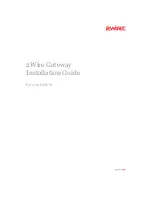
PDN Gateway Overview
▀ Features and Functionality - Optional Enhanced Feature Software
▄ Cisco ASR 5x00 Packet Data Network Gateway Administration Guide
84
This feature now supports standards-based NEMO feature on GGSN, which allows operators to support Enterprise VPN
service with the advantage of faster deployment and flexible bandwidth arrangement for customers.
NEMO (NEtwork MObility) provides wireless connectivity between enterprise core network and remote sites over
3G/4G network. The wireless connection can be used as either primary link or backup link. All the hosts in the remote
site can directly communicate with hosts in the core network without using NAT.
Enterprise VPN service is one of the main use case for this feature. Fast deployment and flexible bandwidth
arrangement for customers are some of the advantages of this service. Customers include banks, financial institutions,
multi-sited enterprises, city public safety departments, transportation fleet, etc.
Overcharging Protection Support
Use of Overcharging Protection requires that a valid license key be installed. Contact your Cisco account representative
for information on how to obtain a license.
Overcharging Protection helps in avoiding charging the subscribers for dropped downlink packets while the UE is in
idle mode. In some countries, it is a regulatory requirement to avoid such overcharging, so it becomes a mandatory
feature for operators in such countries. Overall, this feature helps ensure subscriber are not overcharged while the
subscriber is in idle mode.
P-GW will never be aware of UE state (idle or connected mode). Charging for downlink data is applicable at P-GW,
even when UE is in idle mode. Downlink data for UE may be dropped at S-GW when UE is in idle mode due to buffer
overflow or delay in paging. Thus, P-GW will charge the subscriber for the dropped packets, which isn’t desired. To
address this problem, with Overcharging Protection feature enabled, S-GW will inform P-GW to stop or resume
charging based on packets dropped at S-GW and transition of UE from idle to active state.
Once the criterion to signal “stop charging” is met, S-GW will send Modify Bearer Request (MBReq) to P-GW. MBReq
would be sent for the PDN to specify which packets will be dropped at S-GW. MBReq will have a new private
extension IE to send “stop charging” and “start charging” indication to P-GW.
When the MBReq with stop charging is received from a S-GW for a PDN, P-GW will stop charging for downlink
packets but will continue sending the packets to S-GW.
P-GW will resume sending downlink packets after receiving “stop charging” request when either of these conditions is
met:
When the S-GW (which had earlier sent “stop charging” in MBReq) sends “start charging” in MBReq.
When the S-GW changes (which indicates that maybe UE has relocated to new S-GW).
Session Recovery Support
The feature use license for Session Recovery on the P-GW is included in the P-GW session use license.
Session recovery provides seamless failover and reconstruction of subscriber session information in the event of a
hardware or software fault within the system preventing a fully connected user session from being disconnected.
In the telecommunications industry, over 90 percent of all equipment failures are software-related. With robust
hardware failover and redundancy protection, any card-level hardware failures on the system can quickly be corrected.
However, software failures can occur for numerous reasons, many times without prior indication. StarOS Release 9.0
adds the ability to support stateful intra-chassis session recovery for P-GW sessions.
When session recovery occurs, the system reconstructs the following subscriber information:
Data and control state information required to maintain correct call behavior
















































